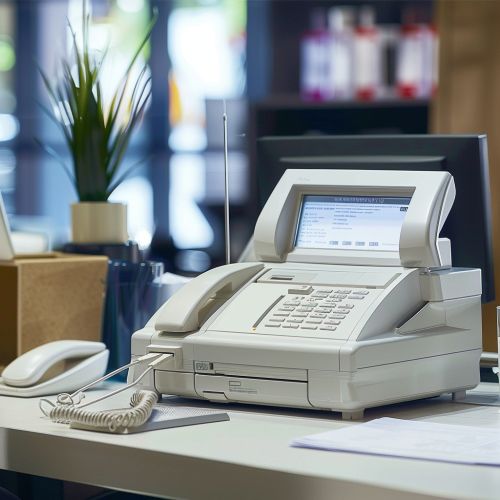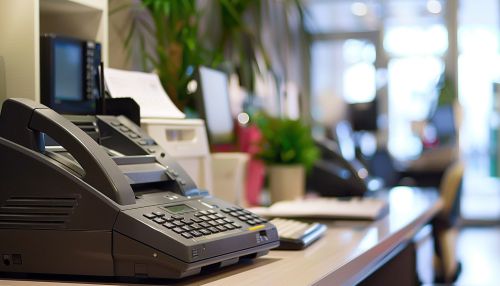Fax machines: Difference between revisions
(Created page with "== Introduction == A fax machine, short for facsimile machine, is a device that transmits scanned printed material (both text and images) via the telephone network to a printer or another fax machine. The technology, which dates back to the mid-19th century, has evolved significantly over the years, playing a crucial role in business communications until the advent of digital communication methods. This article delves into the intricate workings, historical evolution, t...") |
No edit summary |
||
| Line 32: | Line 32: | ||
7. **Printing**: The reconstructed image is printed onto paper. | 7. **Printing**: The reconstructed image is printed onto paper. | ||
[[Image:Detail-92335.jpg|thumb|center|Modern fax machine on an office desk.|class=only_on_mobile]] | |||
[[Image:Detail-92336.jpg|thumb|center|Modern fax machine on an office desk.|class=only_on_desktop]] | |||
== Standards and Protocols == | == Standards and Protocols == | ||
Latest revision as of 23:58, 14 June 2024
Introduction
A fax machine, short for facsimile machine, is a device that transmits scanned printed material (both text and images) via the telephone network to a printer or another fax machine. The technology, which dates back to the mid-19th century, has evolved significantly over the years, playing a crucial role in business communications until the advent of digital communication methods. This article delves into the intricate workings, historical evolution, technical specifications, and modern relevance of fax machines.
Historical Evolution
The concept of faxing dates back to 1843 when Scottish inventor Alexander Bain received a patent for the Electric Printing Telegraph. Bain's device was capable of reproducing graphic signs in laboratory experiments. However, it was not until 1861 that the first commercial fax service was established by Giovanni Caselli, an Italian priest and physicist, with his Pantelegraph.
The 20th century saw significant advancements in fax technology. In 1924, the American Telephone and Telegraph Company (AT&T) introduced the telephotography machine, which could send images over telephone lines. The 1960s marked the advent of modern fax machines, with the introduction of the Xerox Magnafax Telecopier. This compact and efficient device laid the groundwork for the widespread adoption of fax machines in the 1980s and 1990s.
Technical Specifications
Components
A typical fax machine comprises several key components:
- **Scanner**: Converts the physical document into a digital image.
- **Modem**: Modulates and demodulates the digital signal for transmission over telephone lines.
- **Printer**: Reproduces the received digital image onto paper.
- **Control Panel**: Allows users to input commands and manage settings.
Transmission Process
The transmission process involves several steps:
1. **Scanning**: The document is scanned line by line by a CCD or CIS. 2. **Encoding**: The scanned image is converted into a digital signal using MHC or MRC. 3. **Modulation**: The digital signal is modulated into an analog signal by the modem. 4. **Transmission**: The analog signal is transmitted over the PSTN. 5. **Reception**: The receiving fax machine demodulates the signal back into a digital format. 6. **Decoding**: The digital signal is decoded to reconstruct the image. 7. **Printing**: The reconstructed image is printed onto paper.


Standards and Protocols
Fax machines operate based on several international standards and protocols, primarily established by the ITU:
- **Group 1 (G1)**: Introduced in the 1960s, G1 machines used analog signals and required six minutes to transmit a single page.
- **Group 2 (G2)**: Introduced in the 1970s, G2 machines improved transmission speed to three minutes per page.
- **Group 3 (G3)**: Introduced in the 1980s, G3 machines use digital signals and can transmit a page in under one minute.
- **Group 4 (G4)**: Introduced in the 1990s, G4 machines are designed for ISDN lines and offer even faster transmission speeds.
Modern Relevance
Despite the rise of digital communication methods such as email and cloud services, fax machines remain relevant in certain sectors. Industries such as healthcare, legal, and government continue to rely on fax machines due to their security features and legal acceptance of faxed documents.
Security
Fax machines offer a secure method of transmitting sensitive information. Unlike emails, which can be intercepted or hacked, fax transmissions are point-to-point and less susceptible to cyber-attacks. This makes faxing a preferred method for sending confidential documents.
Legal Acceptance
In many jurisdictions, faxed documents are considered legally binding. This is particularly important in the legal and healthcare sectors, where signed documents must be transmitted quickly and securely.
Technological Integration
Modern fax machines have integrated several advanced features to enhance functionality:
- **Internet Faxing**: Allows users to send and receive faxes via the internet, eliminating the need for a telephone line.
- **Multi-Function Printers (MFPs)**: Combine faxing, printing, scanning, and copying capabilities in a single device.
- **Email to Fax**: Enables users to send faxes directly from their email accounts.
- **Fax Servers**: Centralize fax management for large organizations, allowing multiple users to send and receive faxes from their computers.
Future of Fax Machines
The future of fax machines lies in their ability to adapt to evolving technological landscapes. While traditional fax machines may see a decline, the integration of fax capabilities into digital platforms ensures their continued relevance. Innovations such as encrypted faxing and cloud-based fax services are likely to shape the future of this technology.
